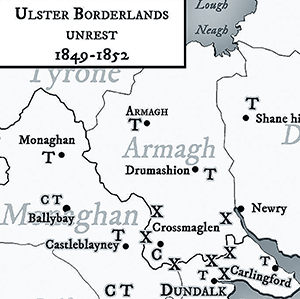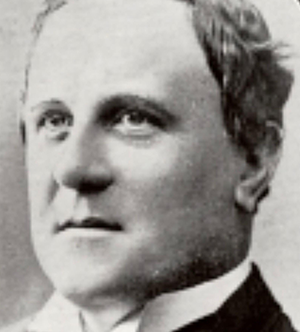ON THIS DAY
Published in Issue 3 (May/June 2022), News, Volume 30BY AODHÁN CREALEY
MAY
09/1908
Luke Livingstone Macassey (c. 65), civil engineer and barrister, died. Macassey is remembered as Belfast’s ‘water hero’, the visionary engineer who brought a reliable supply of clean water to a city whose population had risen from 22,000 in 1807 to 270,000 in 1890 and in so doing probably saved more lives—from typhoid and cholera—than the medical profession at the time. In 1874 the Belfast and District Water Commissioners appointed him as their consultant hydraulic engineer, and he proceeded to build reservoirs above Carrickfergus and Lisburn, which were sufficient for the city’s needs until 1890, when it became clear that drastic action was needed. He and his team investigated five possible sources of water supply, ruled out four (including Lough Neagh) and recommended the Mournes, where rainfall was plentiful and 30 million gallons of water were deliverable every day. Apart from a massive pipeline, a reservoir in the chosen location would be required. The Commission therefore purchased the 9,000 acres of mountain needed for the plans, and in 1905 the pipeline began to deliver water from the Kilkeel and Annalong rivers to a reservoir some 30 miles away to the south of the city, which has provided a plentiful supply ever since. Work then began on constructing a wall to mark the Commission’s catchment area. The famous ‘Mourne Wall’, standing up to 8ft high, 3ft wide and 22 miles in length, which connects the summits of no less than fifteen mountains, including Slieve Donard (850m), was completed by an army of seasonal workers in 1922. Macassey didn’t live to see his proposed reservoir. The Silent Valley reservoir was built between 1923 and 1933 and augmented by the Ben Crom reservoir in 1957.
01/1997
In the British general election, the Labour Party, under Tony Blair, secured a landslide victory, winning 418 seats.
02/1982
During the Falklands War, the Argentinian battle-cruiser General Belgrano was sunk by a British submarine outside the British-imposed 200-mile exclusion zone around the islands; 323 Argentine sailors lost their lives. The Charles Haughey-led Irish government announced its intention to propose the withdrawal of EC sanctions against Argentina.
04/1972
Richard Moore (10) was blinded by a British Army rubber bullet in Derry. He subsequently founded Children in Crossfire (1996), a charity that aims to eradicate poverty and help children in war zones.
07/1992
Eamon Casey, bishop of Galway, resigned after it was revealed that he had fathered a son by an American woman, Annie Murphy.
10/1972
In a referendum on Ireland’s membership of the European Community, almost five to one voted ‘Yes’—1,041,890 in favour, 211,891 against.
18/1922
During continued violence in Belfast, three Catholics were shot dead and three Protestants the following day. Altogether 44 Catholics and 22 Protestants met with violent deaths in the city that month.
21/1972
Ranger William Best (19), a soldier serving with the Royal Irish Rangers in Germany, was shot dead by the Official IRA whilst home on leave visiting his family in Derry’s Creggan estate. The Official IRA called a ceasefire a week later.
22/1922
W.J. Twaddell, MP for Woodvale, West Belfast, was shot dead in Belfast city centre—the only MP to be assassinated in Northern Ireland until the murder of the Revd Robert Bradford in 1981.
26/1972
Minister for Justice Desmond O’Malley reintroduced the Special Criminal Court under Part V of the Offences Against the State Act (1939).
28/1972
Eight people, including four members of the IRA and two women, were killed when an IRA bomb exploded prematurely in the Short Strand area of East Belfast.
JUNE

Above: Map showing the area of activity of James McKnight’s Ulster Tenant Right League. (Tomás Ó Brógáin)
8/1876
James McKnight (75), journalist and agrarian reformer, died. McKnight came to national prominence in 1847 as spokesman for the thousands of Presbyterian tenant farmers who flocked to join the Ulster Tenant Right League, which sought to give legal protection to the Ulster Custom. Regarded at the time as the leading Presbyterian layman, it was he who was chiefly responsible for focusing the aims of the League on the extension of the Ulster Custom to the whole island—the ‘three Fs’: fair rent, free sale and fixity of tenure, meaning no eviction if rent had been paid. This programme was to guide the Irish land reform movement for the next 30 years. His lifelong passion, however, was in the cultural field, as an Irish-speaker who promoted the preservation and publication of ancient Irish manuscripts. Born near Rathfriland, Co. Down, he initially intended to become a Presbyterian minister before turning to journalism and becoming editor of the Belfast News Letter (1829–46). In the columns of that paper, he continually highlighted the common origins of the Irish and Scots Gaelic languages and, by implication, the shared culture of Irish Catholics and their Presbyterian neighbours. As a committed unionist, albeit a liberal one, he was sharply critical of the nationalist politics of Daniel O’Connell. The Repeal campaign, for instance, he described as divisive, suggesting that patriotic sentiment would be better served by reviving and promoting the Irish language. His enthusiasm for the language never waned. On his deathbed, the story goes, he asked his servant, a Catholic, to recite for him the Lord’s Prayer in Irish. She did as he requested, but at one point was interrupted by the dying McKnight, who pointed out that she had mispronounced one of the words.
08/1972
Garda Inspector Sam Donegan (61) was fatally injured by a gelignite bomb reportedly left by the Provisional IRA on the Cavan–Fermanagh border.
05/2002
Alex Maskey (50) became the first Sinn Féin lord mayor of Belfast.
16/1922
The general election resulted in victory for supporters of the Anglo-Irish Treaty, with pro-Treatyites winning 58 seats as opposed to 36 seats for anti-Treatyites.
17/1922
In reprisal for the killings of Catholics in south Armagh, the IRA attacked a number of Presbyterian farmhouses in the townlands of Altanaveigh and Lisdrumliska. Six people were killed and a number of others badly wounded.
17/1972
Five men were arrested during a bungled break-in at the Democratic National Committee headquarters in the Watergate office building in Washington. Their connections with the Richard Nixon re-election campaign committee were to lead to a constitutional crisis.
18/1922
An IRA convention at the Mansion House, Dublin, concluded with a split on the issue of immediate resumption of an IRA offensive against the British Army. The defeated minority, which included three-quarters of the Executive, retired to the Four Courts.
18/1972
BEA Flight 548, en route from London Heathrow to Brussels, crashed near Staines, Middlesex, soon after take-off, killing all 118 people on board, including twelve leading Irish businessmen.
20/1972
In response to a prolonged hunger strike by IRA prisoners in Belfast’s Crumlin Road jail, Secretary of State William Whitelaw announced ‘special category status’.
26/1972
Neil Blaney was expelled from Fianna Fáil for ‘conduct unbecoming a member of the organisation’.
26/1972
The Provisional IRA announced a ceasefire.
22/1922
Sir Henry Wilson, military adviser to the government of Northern Ireland, was shot dead by the IRA in London.
28/1922
At 4.07am a field gun fired across the River Liffey by Provisional Government forces at the anti-Treaty IRA garrison in the Four Courts marked the beginning of the Civil War.

















